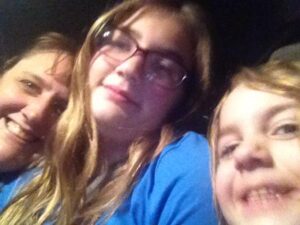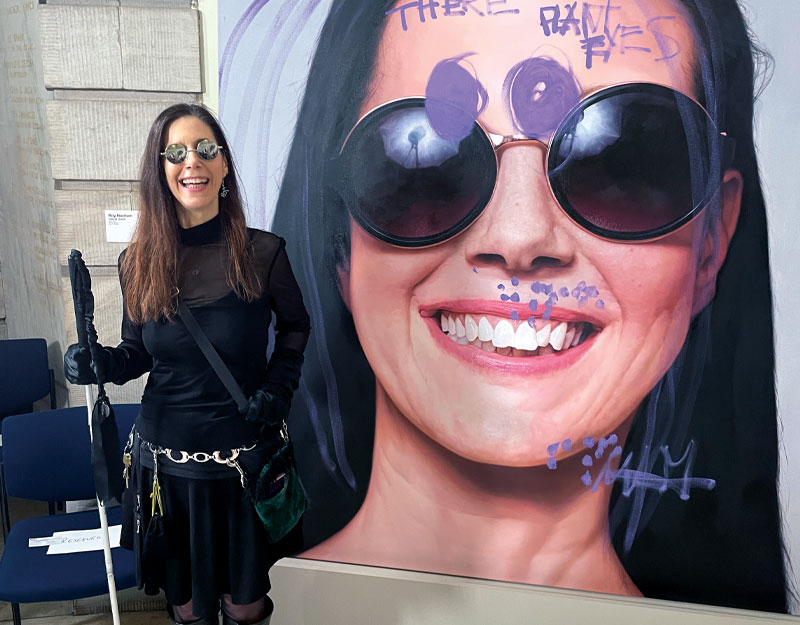Sunday Reflections: The Skin I’m Not Comfortable In, looking back and looking forward at a life with an eating disorder
 I am a teenage anorexic in the body of a fat old woman.
I am a teenage anorexic in the body of a fat old woman.
My struggle with an eating disorder began when I was 12. I was diagnosed with Scoliosis and fitted with a back brace, a type of fiberglass corset. The first time I ever had to wear it out in public I became so body conscious that I threw up. You see this back brace, it was big and bulky and distorted the way my body looked. I had to wear different clothes, elastic waist pants that would fit around it and big baggy shirts to hide the way it flattened my butt. Everything about it made me look bigger and, in my eyes, so abnormal. So I wanted to be smaller, to shrink away so no one would notice. I wanted to disappear.
At the same time, I was being abused by a family member. It’s not something I like to talk about a lot, but I can’t deny that this too was part of the reason I wanted to shrink away. Living in that state of constant fear, lying awake at night wondering if tonight would be the night, more than anything else I wanted to disappear.
ADVERTISEMENT
ADVERTISEMENT
By the time I entered high school I hovered consistently around 100 pounds, give or take a few pounds. I was 5 foot 9.
I got some treatment in high school during my junior and senior years, but my main treatment came in college. 
Ironically, I’ve read enough of the literature out there to know that the reason I am now over weight may be due in part to all of those years of starving my body. Apparently it changes your body metabolism and fearing periods of hunger, your body stores up fat. I have programmed my body to fear hunger at some basic level. And the truth is, I’m just tired of starving and once I started eating again it became so much harder to stop. Six years of barely eating and then three pregnancies with Hyperemesis Gravidarum, I’m tired of the growling pit of starvation and trails of bile that make up so much of my past.
Now I’m the mom to two little girls and the two greatest fears I have for my daughters is that they will somehow be sexually violated or themselves become a member of the eating disorder statistic. I never look in the mirror any more, hoping that they won’t see me obsessing about my weight and pick up those cues. We don’t own a scale. We talk about eating healthy because food is fuel for our bodies and we want to give it the right fuel. I put on a bathing suit and go swimming with them, even when I want to cover myself up in a towel and hide away. I do everything I can to make them feel loved and valued and accepted. But I also appear in very few pictures with them, always using the excuse of hiding behind the camera.
A rare picture of me with my beloveds
The other night I had a scare. I was reading a book on my phone when the battery died. This is a frequent occurrence actually. So I grabbed The Tween’s phone and opened it up and there was an Internet search page full of articles on bulimia. She had searched the term bulimia. I panicked. Why, I wondered, was she searching for this term? Was it for a school assignment? Was she concerned about a friend? Is she okay? Her and the bestie were talking about it and she looked it up. But my vigilance has kicked up a notch. My greatest fear is that one day one of them might come to hate the skin they are in they way I have.
They say you are never cured of an eating disorder, well that’s what my college therapist said. And I must say, I can see the ways in which it lingers. I still hate my body. I still often want to shrink and disappear, hoping that maybe no one will notice me. Sometimes I am still fiercely proud of the extreme self control I had during those days where I only ate a daily bagel and drank 1 can of Pepsi. Sometimes I am fiercely ashamed at the lack of self control I now exhibit when it comes to food. I know that teenage me would look at adult me with nothing but disgust and contempt.
February 22nd through the 28th is National Eating Disorders Awareness Week. Four out of ten individuals struggle personally with an eating disorder or is somehow affected by someone who is. Eating disorders do not discriminate against gender, skin color, income level, or educational background, they can happen to anyone. I’m here to tell you that having an eating disorder sucks. Being hungry and tired and just – languishing – all the time sucks. Hating yourself sucks. The constant dialogue in your head – you’re too fat, you’re disgusting, you’re too weak – sucks. The amount of time you spend obsessing about food, trying to hide whether or not you are eating food, and bargaining with yourself in your head – if I eat this today, I will only eat this tomorrow – sucks. Trying to meet the unrealistic standard of beauty that lives in your head is exhausting. I am tired of thinking about my weight. It’s been thirty years, when can I be at peace with who I am?
My oldest daughter is now the age that it all started to go downhill for me. She’s the age of when my abuse started. She’s the age of when my eating disorder started. I just want to get her through this minefield called adolescence intact. I need you to help me. I need my friends and family and neighbors to do better. I need the TV and radio and movie screens to do better. I need the Internet to do better. We need to be aware of the things we say, the messages we send both explicitly and implicitly. We all need to do better for our youth today. If you break my babies, I don’t know that I’ll ever be able to forgive you. Do better world.
Can you imagine how different our world would be if we cultivated a world where our kids were nurtured intellectually and emotionally? Can you imagine how much better our world would be if we were raising these kids to be healthy adults? But we’re not. But that doesn’t mean we can’t.
For more on National Eating Disorders Awareness Week, check out check out NEDA
For more discussion about body image and eating disorders here at TLT, including an updated book list, check out these posts:
- Top 10 teen titles dealing with body image and eating disorders
- The Girl in the Fiberglass Corset; a story about scoliosis and eating disorders
- Let’s Hear it for the Boys
- Pop Culture and Body Image Issues for Gay Teens, a guest post
- National Eating Disorders Awareness Week: True confessions from a recovering anorexic
- Every Day by David Levithan, a book review
- Butter by Erin Jade Lange, a book review
- The Girl of Fire and Thorns by Rae Carson, a book review
- Skinny by Donna Conner, a review
- A Second Opinion: Every Day by David Levithan
- 10 Titles that deal with Obesity and Body Image (with links to some good articles)
- Today is Love Your Body Day
- The Effects of Pop Culture on the Body Image of GLBT Teens
- Body Image and Weight Loss
- Sex Sells, but what are we selling? Pop culture and body image issues in tweens and teens
- Take a Second Look: Books that encourage teens to look beyond body image
- Abercrombie and Fitch, Brave and Body Image: Part 1 and Part 2
- Skin and Bones by Sherry Shahan
- How I Came to Love School Uniforms: a discussion of girls, boys and the dangerous message of school dress codes
- An eating disorders booklist, updated 2015
Filed under: Body Image, Eating Disorders
About Karen Jensen, MLS
Karen Jensen has been a Teen Services Librarian for almost 30 years. She created TLT in 2011 and is the co-editor of The Whole Library Handbook: Teen Services with Heather Booth (ALA Editions, 2014).
ADVERTISEMENT
ADVERTISEMENT
SLJ Blog Network
Name That LEGO Book Cover! (#53)
Review of the Day: Being Home by Traci Sorell, ill. Michaela Goade
Exclusive: Vol. 2 of The Weirn Books Is Coming in October | News
Fighting Public School Book Bans with the Civil Rights Act
ADVERTISEMENT









Karen, Thank you for being brave enough to share your story today and throughout your blog. As a mom, I’m also scared to death of how the world might hurt and scar my child and whether or not I’m doing enough to make sure he is safe and healthy. I’ve come to see that the first and best thing I can do is share my stories, good and bad, and show him and the teens that I work with that they are not alone.